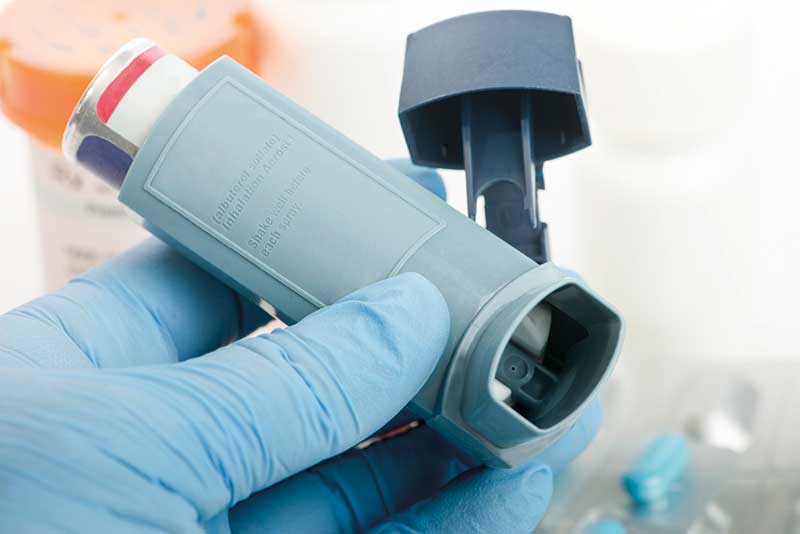BY KATRINA MEGGET | 16 FEBRUARY 2024
The healthcare sector saves lives, but it also contributes a staggering amount of carbon dioxide and other greenhouse gases into the environment. Katrina Megget reports
‘The most carbon-intensive area of the pharmaceutical industry is its supply chain,’ says Amy Booth at the Nuffield Department of Primary Care Health Sciences, University of Oxford, UK. ‘In some cases, more than 90% of their emissions sit with their suppliers.’
The UK’s National Health Service (NHS) estimates that the use of medicines accounts for around 25% of its total emissions, while estimates of the carbon footprint of pharmaceutical use in other country’s healthcare systems varies between 10 and 55% of emissions (A. Booth et al, Int. J. Environ. Res. & Public Health, 2023, 20, 3206).
Some research even suggests the industry is more carbon-intensive than the automotive industry (L. Belkhir et al, J. Cleaner Production, 2019, 214, 185). However, Booth says this research failed to include supply chain emissions and says other research that includes this information has since shown that both industries have similar total footprints (S. Forin et al, J. Cleaner Production, 2022, 331, 129963).
Increasingly, however, pharma companies are tackling their carbon footprints head on. A 2023 study by Booth and her colleagues found that pharma firms are generally reporting their Scope 1 (in-house) and Scope 2 (purchased energy) emissions and increasingly report estimates of their Scope 3 (supply chain) emissions. The study examined the 2020/2021 reports of 20 of the world’s largest pharma companies to analyse and assess their climate change targets, GHG emissions and strategies to reduce them (A. Booth et al, Int. J. Environ. Res. & Public Health, 2023, 20, 3206). Nineteen of these companies had committed to reducing GHG emissions – with 10 aiming to achieve carbon neutrality and eight to net zero emissions between 2025 and 2050.
The study reported that six companies managed to reduce their Scope 1 emissions by more than 20% from their respective baseline year of reporting and eight companies had reduced Scope 2 emissions by 30% or more from their respective baseline year. However, six companies did not report on Scope 3 emissions at all at the time of the analysis, but Booth says many companies have since set more targets and improved their reporting.
‘Pharmaceutical companies continue to be at the forefront of setting ambitious net-zero and carbon-neutrality targets,’ says a spokesperson for the International Federation of Pharmaceutical Manufacturers and Associations (IFPMA), pointing to a 2022 survey of members of the European Federation of Pharmaceutical Industries and Associations (EFPIA). Since 2020, the survey claims that 70% of members have raised their ambition on climate action targets, with 100% reporting long-term targets for CO2 emission reduction, more than 60% citing short-term targets and 60% having set net-zero commitments (EFPIA, EFPIA Survey on Climate Change, 2022).
Varied strategies
Image credit: Sherry Yates Young / Science Photo Library
The most common strategies include using renewable energy, improving energy efficiency in operations, sourcing new materials sustainably, reducing and recycling waste and reducing water use. Many companies are also moving to hybrid or electric vehicles and reducing business travel, while others are supporting tree planting.
GlaxoSmithKline (GSK), for instance, has a target to transition to 100% renewable electricity by 2025, and in 2021 invested £50m at manufacturing sites in Scotland and the US to secure renewable power generation. The firm is also working to find a low-carbon propellant for its metered-dose inhalers - aiming to reduce their emissions by about 90%. Italian firm Chiesi, too, has developed a carbon-minimal pressurised metered-dose inhaler with a new HFA-152a propellant.
US giant Lilly has partnered with renewable energy company Enerpower to construct a 16-acre solar farm in the Republic of Ireland. This will help power a significant proportion of the biopharmaceutical manufacturing facility near Cork, including active ingredients for oncology, immunology and neurology drugs, and is expected to reduce the company’s carbon footprint at the site by 2350t/year.
Meanwhile, COP26 in Glasgow, Scotland, in 2021 saw the launch of the Sustainable Markets Initiative Health Systems Task Force, with the support of AstraZeneca, GSK, Novo Nordisk and others. In March 2023, the public-private partnership released a joint set of minimum climate and sustainability targets for suppliers to incentivise decarbonisation efforts across the supply chain, with each member agreeing to implement the targets as part of their existing supplier engagement programmes. The Task Force has also previously made other commitments, such as reporting emissions from Phase 2 and 3 clinical trials from 2025.
‘With average global temperatures continuing to rise, addressing climate change has become an even more urgent task,’ says Christina Chale, Head of environment, health, safety and sustainability at Astellas Pharma. In March 2023, the Japan-headquartered company announced it had invented the ‘world’s first carbon-neutral blister pack’. The plant-based pill packaging is a polyethylene bioplastic made from sugar cane and sandwiched between two layers of petroleum-based polypropylene, which is more recyclable than the traditionally used polyvinyl chloride (PVC). The company notes the new packaging is neither recyclable nor biodegradable but is carbon neutral; the amount of CO2 emitted when burning the plant-based packs equals the amount consumed by the sugar cane during growth.
By using plant-based materials, Chale says Astellas can reduce the use of petroleum-based plastic materials and cut its carbon footprint by 40-60%, compared with conventional methods. The company has a target of reducing GHG emissions by 90% and a 10% neutralisation of residual emissions to achieve net zero by 2050.
‘Developing a recyclable or biodegradable alternative has proved difficult,’ says Chale, pointing to the need to protect drugs from degradation and ensuring patient safety and meeting regulations. But the new plant-based packaging ‘ticks the boxes’ in terms of tablet protection and usability while also being mass produced, she says; a coup when packaging manufacturers had initially been unwilling to support the development of environmentally friendly pill packs because they viewed the technical obstacles as insurmountable, Chale adds.
Meanwhile, Danish pharma Novo Nordisk has focused on recycling its pre-filled injection pens. In 2020, in the UK alone, 23m Novo Nordisk pre-filled injection pens (used to treat diabetes, obesity and growth hormone disorders) were incinerated or sent to landfill because there was no viable recycling alternative. ‘This puts us at the forefront of [one of] the world’s biggest environmental issues,’ a Novo Nordisk UK spokesperson says. ‘We have developed a process that lets us recycle pre-filled injection pens after their use, with the aim of enabling them to be returned, reclaimed and repurposed.’
The PenCycle Programme, which has launched in Denmark, Brazil and the UK, works on the idea of a circular approach to net zero, giving a second life to the used injection pens such as being repurposed into plastic chairs and lamps. Since the programme’s launch at the end of 2021, more than 200,000 pens in the UK have been returned to Denmark for recycling, equating to approximately 2t of plastic waste. ‘We are always searching for new ways to do more and believe the answers will come as we adapt our business to a circular mindset that keeps our products and material in use,’ the spokesperson says.
Green chemistry
Lea Paterson / Science Photo Library
One area receiving increasing focus from pharma is green chemistry, which aims to reduce or eliminate the use and generation of hazardous chemical substances through the design and application of greener products and processes. Most large pharma companies have adopted green chemistry, says Isamir Martinez, Scientific Alliances and Business Engagement Senior Portfolio Manager at the American Chemical Society (ACS) Green Chemistry Institute (GCI).
‘In general, the pharma industry is receptive to make changes,’ she says. ‘Technologies like flow chemistry, biocatalysis, sustainable metal catalysis and AI/machine learning provide a greener and innovative approach to pharma processes versus traditional chemistry. And a greener process tends to be more cost effective, have a better impurity profile, generate less waste and use less energy – which translates into savings – and more importantly, is the right thing to do.’
Cholesterol drug Lipitor (atorvastatin), antiepileptic drug Lyrica (pregabalin), diabetes drug Januvia (sitagliptin) and Covid antiviral medicine Lagevrio (molnupiravir), for example, have all adopted greener chemistry approaches during manufacture. AstraZeneca also has in late-stage development an undisclosed compound that uses ‘light chemistry’ during the manufacturing process. Exploring light as an environmentally friendly alternative energy source, AZ has generated a more sustainable process to form a carbon-nitrogen bond during amine synthesis and a more efficient way to make anilines. Should the drug be approved, AZ believes the new synthesis involving photocatalytic reactions could save approximately 500t/year of CO2, compared with traditional processes.
Amgen is another proponent of green chemistry, after developing a greener synthesis for its non-small cell lung cancer drug Lumakras (sotorasib). Process optimisation eliminated an unnecessary step that generated copious amounts of solvent waste, boosting yields and also saving more than £3m in operating costs, the Green Chemistry Institute notes.
‘As a company, we believe we have a responsibility to patients, employees, communities and shareholders to do our part to positively impact the health of our planet, just as we do for people,’ says Jim Fisher, Senior Director of environmental sustainability within engineering at California-based Amgen. ‘The improved manufacturing process substantially reduced waste and decreased manufacturing time which enabled the elimination of an entire unit operation that originally created large quantities of solvent waste.’
The company also identified a recycling process for a high-value waste stream that improved efficiency and reduced waste, it is predicted to avoid waste by up to approximately 14,400t/year, he adds. ‘Our investment in environmental sustainability has not only reduced our impact on the planet but also allowed us to be more efficient, productive and resilient, resulting in reduced operating costs,’ he says.
Image credit: Science Photo Library
Much of the drive behind the pharma industry green revolution is centred on sustainability, Chale acknowledges. ‘We believe that a healthy global environment is essential for building a sustainable society and to ensure the continuation of business activities,’ she says.
But money and regulation are also big factors. ‘[Pharma] are primarily driven to engage in climate action to reduce financial risk – like from environmental fines – or to optimise financial opportunity,’ Booth says. Indeed, the EU recently announced plans that could enable regulators to refuse marketing authorisations for medicines on environmentally unfriendly grounds. ‘Some companies have known the carbon footprint of their products for years,’ Booth says, ‘But are only beginning to engage with them now in response to increasing health system awareness and incentives.’
Booth is hesitant whether pharma’s efforts will make a difference. Geographical, regulatory constraints, the prioritisation of patient outcomes and demand for medicines all make reducing GHG emissions challenging. As does the fact that most emissions come from the supply chain and outside the organisations. ‘Significant emphasis is placed on reporting emissions and setting targets, which are not activities that intrinsically result in emission reduction,’ she says. ‘As long as profit is tied to the manufacturing of more products, and the subsequent exploitation of the environment, and regulation is focused on reporting, not reduction, it will be extremely difficult to reach net zero.’
For its part, the industry acknowledges it is not doing enough. A report at the end of 2022 by the UK Office of Health Economics (OHE), commissioned by the Association of the British Pharmaceutical Industry, points to the need for collaboration with governments and healthcare systems (OHE, Supporting the Era of Green Pharmaceuticals in the UK, 2022). ‘We cannot continue to develop lifesaving therapies in a vacuum – global action must be taken to ensure we do not save lives by killing the planet,’ said the OHE’s Chief Executive Graham Cookson. ‘Green pharmaceuticals must become the norm.’







